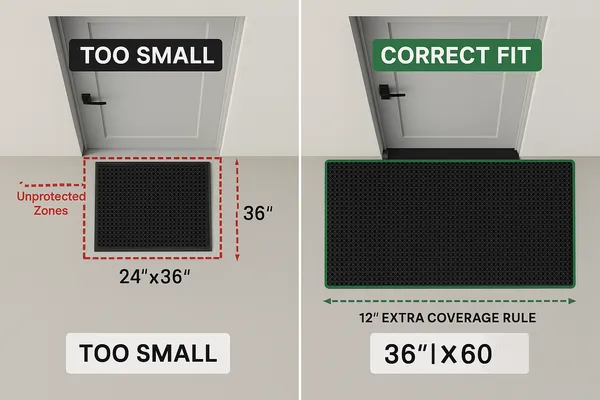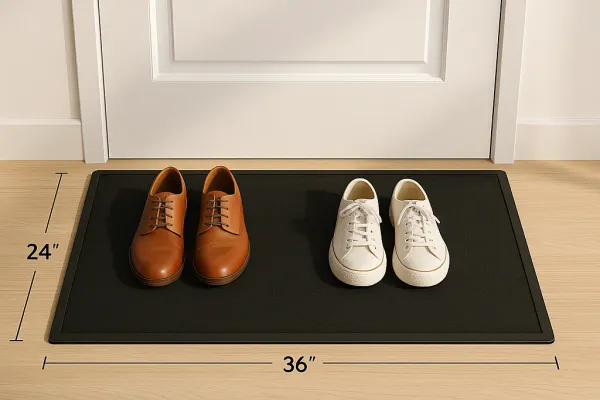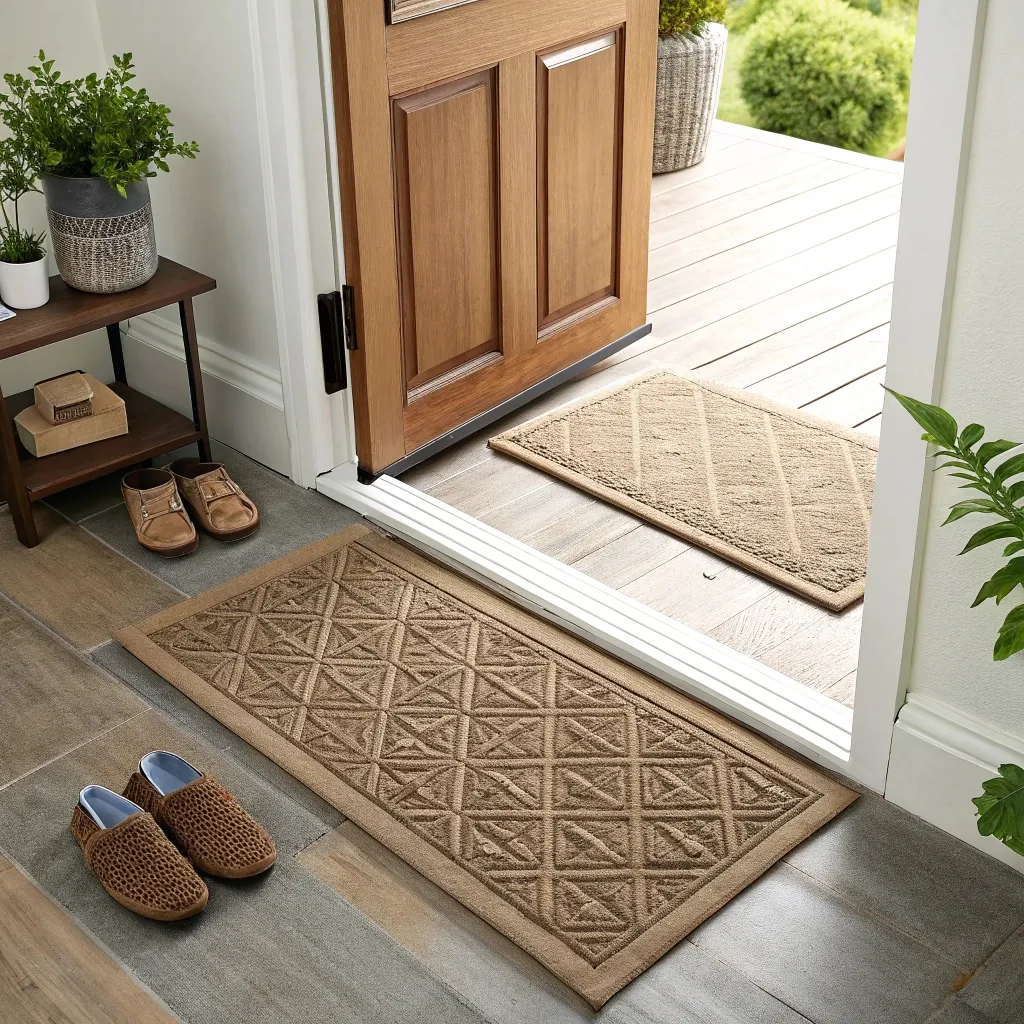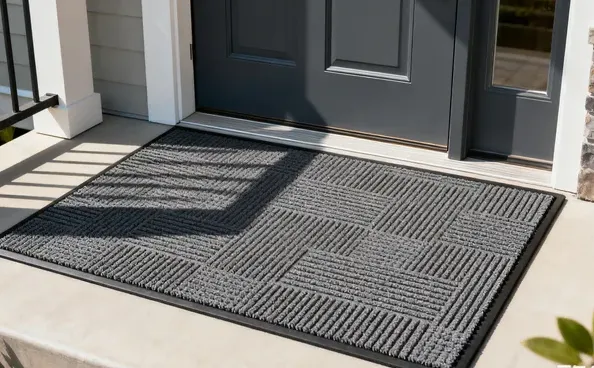When I first bought a doormat, I underestimated the size I would need. The small one barely covered the space and didn’t do much for catching dirt or moisture. It made me realize that choosing the right mat size is essential for both aesthetics and function.
The size of your outdoor mat should fit the area of your entryway, allowing enough space for people to wipe their shoes without stepping off the mat. Generally, outdoor mats range from small (24"x 36") to larger sizes (36" x 60"). Choosing the right mat ensures that your floor stays cleaner and that your mat does its job effectively.

Let’s break down the common questions around the ideal mat size for your front door and outdoor spaces.
What size door mat for front door?
I remember trying different doormats, each one too small or awkwardly placed. Eventually, I learned that the size of the mat is key to both style and function. For front doors, it’s important to pick a mat that covers enough space for everyone to wipe their feet before entering.
A standard front door mat should ideally measure between 30" x 18" and 36" x 24". This allows ample space for a full foot wipe. Larger mats, up to 48" x 30", are also great for wider doorways or double doors.

Choosing the Right Size for Your Front Door Mat
Choosing the right size doormat depends on the width and layout of your entryway. A mat that’s too small won’t provide enough surface area to clean your shoes, while one that’s too large might overwhelm your front door.
1. Measuring Your Doorway
Before selecting your mat, measure the width of your door and the area around it. The mat should cover the width of the door to allow everyone to wipe both shoes completely. For a single door, a mat size of 30" x 18" works well. If your front door is larger or includes sidelights, a bigger mat, like 36" x 24", is more appropriate.
2. Double Doors and Larger Entryways
For homes with double doors or larger entryways, consider a mat size of 48" x 30" or even larger. A broader mat ensures that guests can wipe their feet even when approaching from different directions. Additionally, large mats create a welcoming feel, enhancing curb appeal.
3. Placement and Aesthetic
While size is important for functionality, it’s also worth considering the aesthetic of your home. Ensure the mat is centered in front of the door and aligns with the width. Avoid mats that crowd the area or cover too much of the porch, as they can detract from the overall look.
When I switched to a 36" x 24" mat for my front door, I noticed a more polished look, and it provided ample space for everyone to wipe their feet.
Is it better to have door mat inside or outside?
I used to place my mat inside the door, but I quickly realized that it was ineffective at keeping dirt and moisture outside. Over time, I started wondering whether it’s better to have the mat inside or outside the door.
It’s generally better to place the mat outside the door. This helps capture dirt, moisture, and debris before it enters your home. Having an Außenmatte1 ensures that your indoor floors stay cleaner and drier.

Benefits of Placing Your Doormat Outside
I found that an outdoor mat works best for trapping dirt before it reaches the threshold of my home. Let’s explore the advantages of placing a mat outside versus inside:
1. Keeping Dirt Outside
Placing the mat outside ensures that the bulk of dirt, mud, and moisture are removed from shoes before entering. It’s much easier to clean the mat outdoors, and it prevents the indoor space from getting dirty quickly.
2. Protection from Weather
An outdoor mat serves as a buffer between the elements and your entryway. It can catch rainwater, snow, or dust, keeping your home’s floors drier and cleaner. PVC or rubber mats designed for outdoor use dry quickly and resist wear, ensuring they remain effective no matter the weather.
3. Durability and Maintenance
Outdoor mats are built to withstand the elements. With regular cleaning, they remain in good shape. Inside mats, on the other hand, don’t get exposed to as much dirt but might retain more dust and moisture over time. They often need more frequent washing or vacuuming.
In my experience, an outdoor mat works best because it catches dirt before it can be tracked inside. I also find that the mat dries faster outdoors than indoors, and I don’t have to clean it as often.
What is the best doormat for sandy feet?
Living near the beach, I struggled to keep my floors clean with all the sand people brought inside. I learned that not all doormats are suited for sand, so choosing the right one became a priority.
The best doormat for sandy feet is one made from coarse materials like coir or a rubber mat with raised, textured surfaces. These mats are designed to trap sand effectively and release it when shaken.
Choosing the Right Doormat for Sandy Feet
If you live in a sandy area or near the beach, a standard doormat might not do the job. It’s important to find a mat designed to handle and trap sand before it gets inside.
1. Kokosmatten2
Coir mats, made from coconut husk fibers, are highly effective at scraping sand off shoes. The coarse texture helps remove particles from shoes and boots, and the natural fibers allow sand to fall through the mat. However, they can be harder to clean if the sand builds up. Shaking them outside can help, or using a vacuum cleaner for deep cleaning.
2. Rubber Mats with Raised Textures3
Rubber mats with raised textures or grids trap sand and dirt and prevent it from being tracked into the house. These mats are often more durable than coir and easier to clean with a hose or sponge. They work well in beachside homes or homes where people frequently bring in dirt and sand.
3. PVC Mats
Some PVC mats feature holes or grids that allow sand to fall through, leaving the surface clean. These mats are often lightweight and easy to shake or rinse. The water-resistant properties also ensure that sand won’t stick to the mat when wet.
When I switched to a rubber mat with raised ridges, I noticed significantly less sand in my house. It trapped the particles efficiently, and a quick shake cleared it out in no time.
What kind of mat is best for front door?
After trying various mats, I realized that the best front door mat should be durable, functional, and weather-resistant. It should effectively remove dirt and moisture while complementing your home’s style.
Rubber, PVC, and coir mats are often the best choices for front doors. These materials are tough, weather-resistant, and easy to clean. Rubber mats offer durability and traction, while coir mats provide an attractive, rustic feel.
Selecting the Best Front Door Mat
Choosing the right mat for your front door requires balancing functionality with appearance. The material and texture matter, as they determine how well the mat traps dirt and moisture.
1. Rubber Mats
Rubber mats are excellent for front doors, as they are waterproof and have a non-slip surface that keeps them securely in place. They also work well in various weather conditions, from rain to snow. The raised patterns on rubber mats scrape dirt off shoes effectively.
2. PVC-Matten4
PVC mats are durable, water-resistant, and easy to clean. They can handle heavy foot traffic and often feature drainage holes to allow water to escape, keeping the mat dry. These mats come in various designs, so you can find one that fits your aesthetic preferences.
3. Coir Mats
Coir mats offer a natural, eco-friendly option for front doors. They’re made from coconut husk fibers, which effectively scrape dirt from shoes. While coir mats are great at trapping dirt, they can be harder to clean, especially if the dirt builds up over time. Shaking them out regularly or vacuuming them helps keep them effective.
4. Combination Mats
Some mats combine rubber or PVC with a coir or fabric surface, providing the benefits of both materials. These mats are versatile and often feature strong dirt-trapping qualities while also being easy to clean.
After switching to a rubber mat with a simple, stylish design, I found that it not only worked well in all weather conditions but also provided a more modern look to my entryway. It was easy to clean and lasted longer than the coir mats I had tried before.
Abschluss
Auswählen the right outdoor mat for your front door comes down to functionality, size, and material. For sandy feet, a rubber or PVC mat works best, while a coir mat is a great choice for dirt-heavy areas. Whether you place your mat inside or outside, make sure it’s large enough to effectively clean shoes and withstand the weather.
-
Explore the advantages of outdoor mats, including their durability and effectiveness in keeping your home clean. ↩
-
Learn more about Coir Mats and how their unique properties make them ideal for sandy environments, enhancing your home’s cleanliness. ↩
-
Find out how Rubber Mats with Raised Textures can effectively trap sand and dirt, making them a practical choice for beachside living. ↩
-
Discover why PVC mats are durable and easy to clean, making them ideal for high-traffic areas at your front door. ↩




